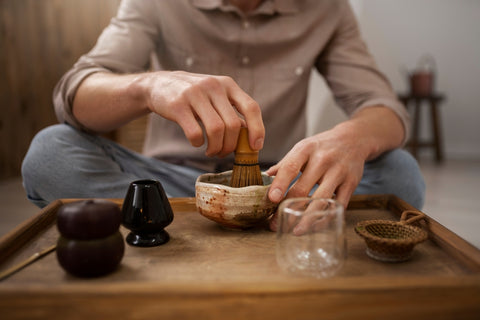Did you know that macha and maccha are both common spellings of matcha (抹茶), a Japanese word for a powdered green tea? Macha is a nutrient-packed variety of green tea powder where you ingest whole tea leaves that are finely ground-up after being shade-grown at the end of their harvest.

Matcha tea has become popular far outside its country of origin – Japan – often now sold in tea shops, health-food stores, and by online vendors. Though the word for this finely powdered green tea is usually spelled 'matcha' in the US and other English-speaking countries, there are different and accepted ways to spell matcha throughout the world – such as maccha and macha.
Where did the word matcha come from?
Originating from Japan, matcha comes from an old Japanese word, 'matsu,' which means ground, and 'cha,' which means tea.
Though the Japanese coined the term matcha, the origins of green tea powder lie in China. Matcha was first introduced to Japan back in the 1100s by a Zen Buddhist monk who brought green tea seeds with him upon returning from studying in China. He helped create the foundation for "the way of tea" In Japan, by which the quintessential preparation of tea was an exercise focused on beauty, honor, and devotion in an otherwise flawed world.

Macha was specifically grown, harvested, and powdered to be used in a tea ceremony. It was whisked in hot water and drunk instead of being strained and removed from the water like most loose-leaf teas.
How do you spell matcha tea?
When words like matcha that come from a language such as Japanese are translated into another language like English, it's common that the new spelling of the word is not agreed upon. In the case of matcha, there are three quite common spellings that all fit the definition of what is understood to be matcha green tea powder.
The three most common ways to spell matcha are:
- Matcha
- Macha
- Maccha
How is matcha pronounced?
English is a West Germanic language that has acquired many words from non-Germanic languages, and the spelling of a given word often reflects its origin. In the case of matcha, the variations in how to spell matcha come from the variations in how the Japanese word matcha is pronounced in English.

In the case of matcha, it is generally pronounced maa ·chuh.
The trick with matcha is there is an unspoken guttural pause in the world. And that is tricky for non-native Japanese speakers to pronounce!
It's almost as if you stutter … or take a beat between the two syllables.
In a way, the Japanese language is accentless compared to all the different variations of English you find worldwide. So, in Japanese, if you try to pronounce each syllable without using an accent, you will likely sound more natural.
Mah-cha is close, but the correct sound could also be more like mah-ccha. Or … another way to think about it mah - hh - cha. Take three beats.
Other people also commonly pronounce it in english as Mah-ch-cha.
So in a way, the correct way to phonetically pronounce matcha would make maccha the most sensible way to spell it – yet matcha with a 't' is still the most common.
Once you've practiced pronouncing matcha, you can probably better understand why there are three common variations in the spelling!
What is macha?
Macha isn't just any green tea powder. It is a high-grade green tea ground into powdered form that is then prepared by being whisked into hot water instead of steeped to form a frothy drink. Macha is grown, harvested, and stone-ground in a special manner, which leads to it having such high amounts of l-theanine, chlorophyll, caffeine, and other health-supporting nutrients.
How is macha grown?
Over centuries, Japanese farmers have grown macha under special farming conditions. In the last three weeks before harvest, the green tea plants are covered by dark tarps or bamboo shades, shielding the matcha tea leaves from the sun and triggering an overproduction of chlorophyll and l-theanine – which gives maccha tea its hallmark bright green color.

This growing process also maximizes matcha's health benefits and adds to the slightly nutty, vegetal, and umami flavor you taste when you consume your matcha.
How is maccha prepared?
Following their time spent in the shade, young Tencha tea leaves are harvested. They are hand-picked, de-stemmed, deveined, steamed, and then air-dried. Then, when the leaves are ready to be sorted into the various grades of matcha – with the youngest, greenest tea leaves from the first harvest flush being used in ceremonial grade matcha to later harvest flushes being used to create culinary grade matcha.
Once sorted, the tea leaves are then carefully stone-ground – leading to an ultra-fine, high-quality green tea maccha powder that can be consumed in hot or cold form.





 You may also like:
You may also like: 

